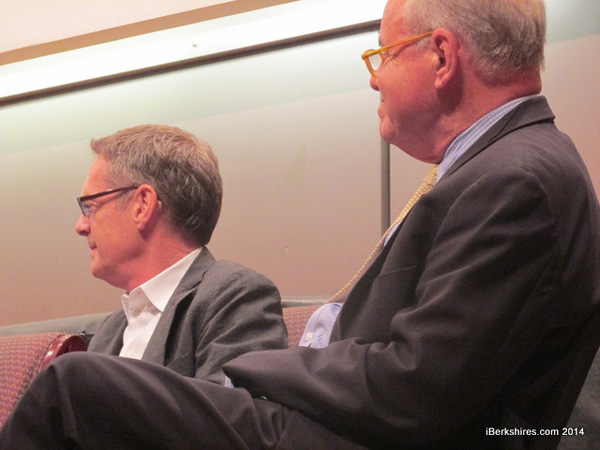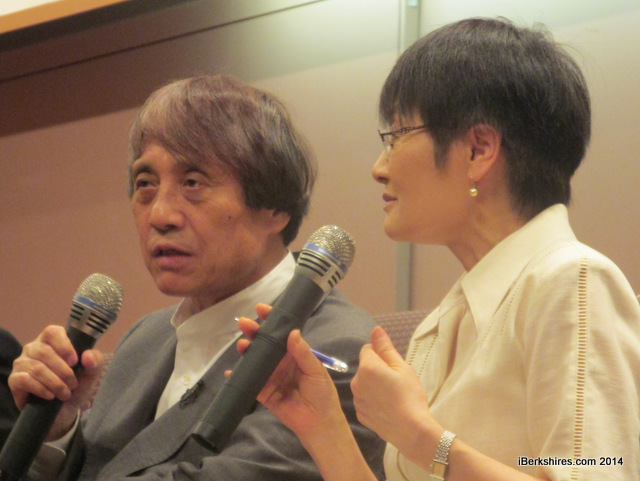Red-letter Day: Clark Art's Granite Helps Tie Campus TogetherBy Stephen Dravis, iBerkshires Staff
09:30PM / Sunday, June 29, 2014 | |
 Clark Art Director Michael Conforti, right, and landscape architect Gary Hilderbrand follow the discussion. Clark Art Director Michael Conforti, right, and landscape architect Gary Hilderbrand follow the discussion. |
|

Japanese architect Tadao Ando participates in Saturday's panel discussion with the help of his interpreter, right.
|
WILLIAMSTOWN, Mass. — One of the Clark Art Institute's special exhibitions this summer celebrates how a pioneering sculptor rediscovered the use of color in his medium.
On Saturday, the architectural team behind the Clark's renovation and expansion explained how a critical color choice helped pull that project together.
At the outset of the more than decade-long endeavor, the Clark was faced with two seemingly irreconcilable realities: It wanted a world-renowned architect to be the driving force behind the expansion, and it needed him to work with a color pallette that was as foreign to him as he was to the Berkshires.
Tadao Ando, who won a Pritzker Prize and the competition to helm the Clark's transformation because of his mastery of simple, uncolored concrete, needed to be convinced that red granite be incorporated into what is now known as the Clark Center, the museum's new visitor and exhibition space.
"One of the first meetings that [Clark Director] Michael [Conforti] came to Osaka, he brought with him two big pieces of boulder -- one was pink and one was white -- and he put them on the table where we had the meeting, and he said, 'The design has to incorporate this DNA,' " Ando associate Kulapat Yantrasast said during a panel discussion on art and architecture. "This is the DNA of the Clark, which is the granite and the marble.
"And I think knowing that Mr. Ando designed in concrete, it was a gentle challenge."
The capacity crowd in Williams College's Brooks-Rogers Recital Hall laughed at the Yantrasast's characterization, and the panel's moderator interjected to show how much of a challenge Conforti was laying down.
"I guess we should all consider ourselves lucky the meeting didn't end at that point," Vanity Fair architecture critic Paul Goldberger said.
Yantrasast continued.
"It was his way of almost playing chess," he said of Conforti's challenge. " 'This is my move. Let's see how you respond.' ... Hopefully we have achieved a great balance of material on the inside and outside."
The balance was sorely needed.
Conforti's call for use of architectural materials already dominant on the Clark's campus spoke to one of the fundamental aims of the expansion: bringing a sense of cohesion to the South Street campus.
Now that the project is finished and the public grand reopening less than a week away, Goldberger can comfortably criticize the look of the "old Clark" on a panel hosted by the museum, featuring Conforti and held in front of a crowd populated largely by museum patrons.
"The Clark had felt, for me, for a long time, like a very distinguished institution located in a pair of not entirely distinguished buildings that were locked in a kind of awkward marriage with each other," Goldberger said. "When I first saw the completed project, the extraordinary thing for me was that it had gone from being a bad marriage to being a good family, which is quite a remarkable feat.
"By adding a third superficially different element, the enitre thing became a coherent synthesis, which is quite a remarkable achievement."
In his response, Ando modified Goldberger's family metaphor, suggesting that the Clark's original 1955 white marble building is the grandfather, the 1973 red granite Manton Research Center is the offspring, and his Clark Center is the grandchild.
"The three generations are tied by a central water feature," Ando said.
Goldberger picked up on that theme, noting that, "As with many families, the grandchild brings together the previously warring generations."
At the Clark Center, Ando's signature "seven wall" (so-called because it is shaped like the number when viewed from above) is clad in granite from the same quarry that gives the Pietro Belluschi-designed Manton Center its look.
Ando said it was the first time he worked with stone and he only did so because it was already in use on the site -- part of the DNA, as Yantrasast would say.
Another element of the Clark's DNA: its connection with nature.
Landscape architect Gary Hilderbrand told the audience that the new Clark with its central water feature and parking on the north side of the visitors center celebrates the landscape that could have been lost in the campus' old orientation, where visitors parked behind the Manton and immediately entered through it to rush to the exhibits.
"Without going into too much detail about how we achieved this, it seems today that the landscape, which you know is embodied in many of the paintings ... absolutely resonates with the fact that when you walk down the path and through a little notch in the [visitors center], the Clark seems to be about landscape," Hilderbrand said. "That transformation from scooting around the back and not even seeing it and thinking about the ditch just beyond the parking lot as a barrier ... Now, you won't even go to the Clark without that incredible panorama.
"That meant almost picking everything up and gently putting it back."
The transformation of the Clark campus is complemented by an interior transformation to the 1955 "white" building by Annabelle Selldorf.
On Saturday morning, Selldorf echoed Hilderbrand's sentiment about slowing down the visitor so instead of "scooting" past the beauty, they have the opportunity to embrace it.
"I go back to what [Goldberg] said earlier: In order to conserve you have to radically intervene," Selldorf said.
"I think we changed everything in such a way that you have to discover it. ... Affording people to take time and really look at the art rather than just running around the building in the way they were doing it before was essentially the objective."
As for Conforti's objective at that Osaka meeting, it was clear on Saturday morning that he won over Ando.
"It was a really difficult question," he said through his translator. "I looked at it, looked it, thought about it and finally decided the past has to be respected.
"I saw it this morning. Actually, I saw it yesterday as well. Now, I'm very happy I chose the stone."
"Michael has been waiting 10 years to hear that," Goldberger quipped.
| 
 MEMBER SIGN IN
MEMBER SIGN IN
 MEMBER SIGN IN
MEMBER SIGN IN